Adding some color to the chaos
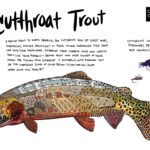
Bri Dostie is sharing coloring pages for families to use during the coronavirus quarantine hoping to keep students learning about the native fish and ecosystems of the country.

Bri Dostie is sharing coloring pages for families to use during the coronavirus quarantine hoping to keep students learning about the native fish and ecosystems of the country.
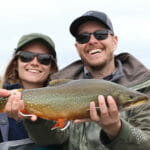
Namebini has been a Northern Minnesota business since 2007, taking its name from the original Ojibwe name for the nearby Sucker River. We offer guided fly fishing in both Minnesota and Wisconsin for brook, brown and rainbow trout, as well as steelhead, salmon, smallmouth bass and northern pike. Streams and rivers in Northern Minnesota and Wisconsin…
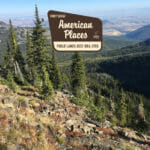
Region: Northern RockiesActivities: Hiking, Sightseeing, FishingSpecies: Rainbow, brook and cutthroat trout Where: Ninemile Valley is 20 miles west of Missoula, in west central Montana. The valley bottom consists mostly of private property; the upper lands are part of the Lolo National Forest. Ninemile Creek is a major tributary of the Clark Fork, Montana’s largest river.…
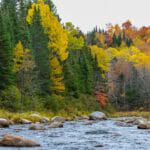
Trout Unlimited’s Land Conservancy Fund is a matching grant program designed to provide chapters and councils with grants to help with land protection projects, including conservation easements and land trust or agency acquisition and/or ownership of properties that are a priority for native and wild trout and salmon populations. The program is administered by the…
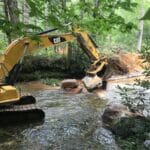
Small donations from private foundations provide seed money needed to get a big restoration project going

Socks – unless you live in a climate a lot friendlier than Wyoming, you wear ‘em. But that doesn’t mean they have to be boring. How’d you like to lose those white crews and wear some socks that stand out? Better yet, how’d you like to have awesome socks and do some great things for…
When you think of Farm Bill conservation, what comes to mind? Maybe fields full of pheasants or ringed by deer stands? Prairie potholes for waterfowl? What about fish – perhaps a little farm pond full of bluegills and bass? Our friends at the Theodore Roosevelt Conservation Partnership put together an excellent overview of how…
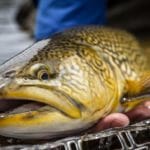
The head of a tiger trout. Paul Burnett/Trout Unlimited. By Brett Prettyman This is the tale of two fish. The take was similar. The tug was not. One easily provided more thrill than the other, but it was not the fish you would expect. I recently had the chance to visit the family ranch of…
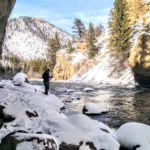
Most of trout country is in the grips of winter, but that doesn’t mean trout fishing has to stop. Fly fishing for winter trout can be just as productive as spring, summer or fall fishing if anglers take care to adjust to the changes in trout behavior, habitat and, of course, cold temperatures that might…
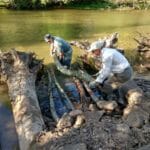
By Cal Curtice “This is probably the last generation of trout fishers.” — Forest and Stream Magazine 1879 In 1620, virgin forest covered the United States from the tip of northern Maine, south to central Florida, and west beyond the Mississippi River. Native brook trout swam throughout their cool, clean waters, including those in the Finger…
Oct. 28, 2014 Contact: Katy Dunlap, Trout Unlimited Eastern Water Project Director, 607-742-3331 Mark Taylor, Trout Unlimited Eastern Communications Director, 540-353-3556 FOR IMMEDIATE RELEASE WASHINGTON, D.C.Trout Unlimited is featuring the George Washington and Jefferson national forests in Virginia and West Virginia in a new report highlighting outstanding public fishing and hunting areas in the Central…
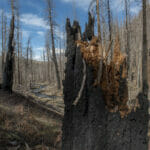
Last year the workgroup developed a new volunteer council role, Council Climate Change Coordinator. Communicating a consistent TU science-based message on climate change, whether it’s raising awareness or advocating a Trout Unlimited position, is the primary responsibility of this role.
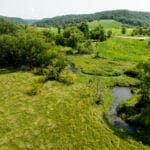
Over 135 people attended the 2025 Driftless Symposium hosted by the Trout Unlimited Driftless Area Restoration Effort and the Wisconsin Wetlands Association on Tuesday February 25 in La Crosse, Wisc. Several common threads emerged among this year’s presentations, highlighting both threats to watershed health and the countermeasures being developed to face those threats. Threats to…
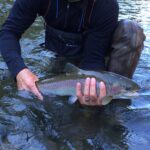
The stuff of dreams, Trinity River. By Sam Davidson The first hints of autumn always seem to bring things into sharper relief. When you have spent almost no time lately with a rod in hand, not taking advantage of the last wet-wadable days of the year, that clarity can be unwelcome. Thank goodness for social…
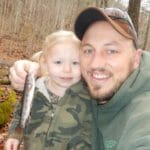
Dustin Wichterman and daughter Brooklynn quickly pose with a West Virginia brook trout before releasing the fish. By Dustin Wichterman To say that angling has always been a big part of my life is probably an understatement. It has been imprinted from both sides of my family, and after finding out that several of my…
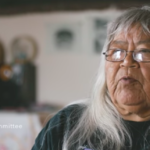
The Arctic National Wildlife Refuge is in the news again, as the oil and gas industry—sensing more friendly political winds— takes another shot at the effort to sink oil wells into the permafrost north of the Brooks Range. A couple of summer ago, I topped the Brooks Range on the Dalton Highway and got my…
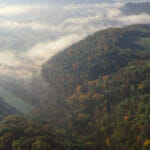
For the past two years, the DARE team has been providing free pollinator seed to enhance Driftless Area streams. The seed mix is not intended to replace the planned seeding mixture, but to supplement pollinator plants into the mixture.
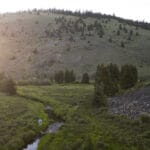
USFWS fish passage funding provided by the Bipartisan Infrastructure Law will support TU projects in Priority Waters across eight states
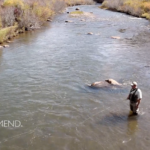
We often make fly fishing more complicated than we need to. A good example of that is mending our fly line to get a better, more natural drift as our flies work their way downstream. Often, as TU’s Kirk Deeter points out in the video below, our mends are too jerky or move the flies…